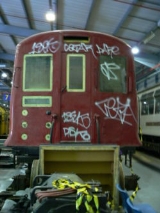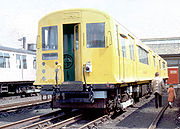
London Underground Q Stock
Encyclopedia
The Q Stock consisted of various District Line
trains built from 1923 (G Stock) until the mid 1930s, originally built with manually operated sliding doors. Following conversion to air operated doors, the trains became collectively known as Q Stock
. Given that five different types of rolling stock were converted to Q Stock, the resulting hybrid trains looked bizarre - with the older carriages having flat sides and clerestory roofs, whilst the Q38 had flared sides at floor level.
by Gloucester RC&W to operate with the older, converted cars. The units had a similar profile to the Metropolitan Line
O/P Stock
built in 1935 and to the R47 Stock
, R49 Stock
, and R59 Stock
built between 1949 and 1959.
The Q38 stock consisted of 25 driving motor cars and 183 trailers. Motor cars were numbered in the District line 4xxx series whilst the trailer cars were numbered with the O and P stock trailers.
The Q38 trailers first entered service on the District Line 14 November 1938, and the motor cars (with some trailers) on the Metropolitan Line on 27 March 1939. With the introduction of the P stock on the Metropolitan Line from 17 July 1939, the Q stock trains were redeployed on the District Line, a process which had been completed by the end of November 1939.
, being converted into Driving Motor cars and reclassified R38 Stock
. The conversion to R stock was helped by the fact that one end was designed to be easily convertible to a driving cab, including the provision of driver's cab doors.
In 1959/60, 17 Q38 trailers were converted for use as trailers with the CO / CP Stock
. This was in connection with the conversion of Circle Line trains from five to six cars in length. A further eight were converted when the A62 stock displaced the P stock on the Metropolitan Line, with the P stock being transferred to the District Line.

, before withdrawal in 1971. The Q Stock was replaced on the District Line by CO/CP Stock displaced from the Circle Line and Hammersmith & City Line by the introduction of C69 Stock.
Two driving motors have been saved for preservation
District Line
The District line is a line of the London Underground, coloured green on the Tube map. It is a "sub-surface" line, running through the central area in shallow cut-and-cover tunnels. It is the busiest of the sub-surface lines. Out of the 60 stations served, 25 are underground...
trains built from 1923 (G Stock) until the mid 1930s, originally built with manually operated sliding doors. Following conversion to air operated doors, the trains became collectively known as Q Stock
London Underground Q Stock
The Q Stock consisted of various District Line trains built from 1923 until the mid 1930s, originally built with manually operated sliding doors. Following conversion to air operated doors, the trains became collectively known as Q Stock...
. Given that five different types of rolling stock were converted to Q Stock, the resulting hybrid trains looked bizarre - with the older carriages having flat sides and clerestory roofs, whilst the Q38 had flared sides at floor level.
Q38 Stock
The Q38 Stock was built in 1939 for the District LineDistrict Line
The District line is a line of the London Underground, coloured green on the Tube map. It is a "sub-surface" line, running through the central area in shallow cut-and-cover tunnels. It is the busiest of the sub-surface lines. Out of the 60 stations served, 25 are underground...
by Gloucester RC&W to operate with the older, converted cars. The units had a similar profile to the Metropolitan Line
Metropolitan Line
The Metropolitan line is part of the London Underground. It is coloured in Transport for London's Corporate Magenta on the Tube map and in other branding. It was the first underground railway in the world, opening as the Metropolitan Railway on 10 January 1863...
O/P Stock
London Underground O Stock
The O and P Stock was built for the Metropolitan Line and Hammersmith & City Line in 1937–1940 by Gloucester RC&W and Birmingham RC&W. In all there were 262 driving motors and 103 trailers...
built in 1935 and to the R47 Stock
London Underground R Stock
The R38, R47, R49, and R59 Stock cars were built for the District Line in 1938, 1949, 1952 and 1959. R Stock cars were driving motors and non-driving motors...
, R49 Stock
London Underground R Stock
The R38, R47, R49, and R59 Stock cars were built for the District Line in 1938, 1949, 1952 and 1959. R Stock cars were driving motors and non-driving motors...
, and R59 Stock
London Underground R Stock
The R38, R47, R49, and R59 Stock cars were built for the District Line in 1938, 1949, 1952 and 1959. R Stock cars were driving motors and non-driving motors...
built between 1949 and 1959.
The Q38 stock consisted of 25 driving motor cars and 183 trailers. Motor cars were numbered in the District line 4xxx series whilst the trailer cars were numbered with the O and P stock trailers.
The Q38 trailers first entered service on the District Line 14 November 1938, and the motor cars (with some trailers) on the Metropolitan Line on 27 March 1939. With the introduction of the P stock on the Metropolitan Line from 17 July 1939, the Q stock trains were redeployed on the District Line, a process which had been completed by the end of November 1939.
Numbers
| 'A' DM | 'D' DM | 'A' T | 'D' T |
|---|---|---|---|
| 4402 - 4420 (even) | 4409 - 4437 (odd) | 013102 - 013192 | 014101 - 014192 |
Conversions
After the war, 132 of the trailer cars were rebuilt for use with the R StockLondon Underground R Stock
The R38, R47, R49, and R59 Stock cars were built for the District Line in 1938, 1949, 1952 and 1959. R Stock cars were driving motors and non-driving motors...
, being converted into Driving Motor cars and reclassified R38 Stock
London Underground R Stock
The R38, R47, R49, and R59 Stock cars were built for the District Line in 1938, 1949, 1952 and 1959. R Stock cars were driving motors and non-driving motors...
. The conversion to R stock was helped by the fact that one end was designed to be easily convertible to a driving cab, including the provision of driver's cab doors.
In 1959/60, 17 Q38 trailers were converted for use as trailers with the CO / CP Stock
London Underground O Stock
The O and P Stock was built for the Metropolitan Line and Hammersmith & City Line in 1937–1940 by Gloucester RC&W and Birmingham RC&W. In all there were 262 driving motors and 103 trailers...
. This was in connection with the conversion of Circle Line trains from five to six cars in length. A further eight were converted when the A62 stock displaced the P stock on the Metropolitan Line, with the P stock being transferred to the District Line.

Withdrawal
In the final years of service, Q Stock units were used on the East London LineEast London Line
The East London Line is a London Overground line which runs north to south through the East End, Docklands and South areas of London.Built in 1869 by the East London Railway Company, which reused the Thames Tunnel, originally intended for horse-drawn carriages, the line became part of the London...
, before withdrawal in 1971. The Q Stock was replaced on the District Line by CO/CP Stock displaced from the Circle Line and Hammersmith & City Line by the introduction of C69 Stock.
Two driving motors have been saved for preservation
- DM no. 4416 - London Transport Museum, ActonActon, LondonActon is a district of west London, England, located in the London Borough of Ealing. It is situated west of Charing Cross.At the time of the 2001 census, Acton, comprising the wards of East Acton, Acton Central, South Acton and Southfield, had a population of 53,689 people...
- DM no. 4417 - London Transport Museum, ActonActon, LondonActon is a district of west London, England, located in the London Borough of Ealing. It is situated west of Charing Cross.At the time of the 2001 census, Acton, comprising the wards of East Acton, Acton Central, South Acton and Southfield, had a population of 53,689 people...

